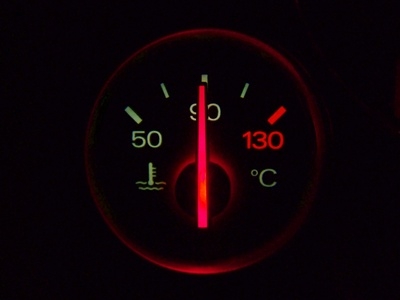
Troubleshooting the thermostat in an automobile will determine if that is the cause of overheating. The thermostat regulates the engine temperature and prevents it from running too hot. The thermostat opens once the engine starts going past the designated temperature and releases coolant through the engine. The water pump on the engine pushes the coolant to the radiator where the heat is dissipated. A faulty thermostat will stick and not allow coolant to complete this cycle.
Open the hood to inspect the thermostat. Start the car and allow it to idle to warm up the engine.
Observe the top radiator hose. (On some vehicles the bottom radiator hose runs to the thermostat housing; consult the owner's manual to be sure.) Feel the hose for warmth. This will indicate that the vehicle is warming up and the thermostat should open to release coolant to the engine.
Check the temperature gauge on the instrument panel. It should stay in the middle range. Observe if the gauge starts rising to "hot". When it does, feel the radiator hose; if it feels hot and like it is full of coolant, this will indicate that the thermostat is not opening.
Turn the vehicle off and allow it to sit for at least an hour to cool. Remove the bolts holding the thermostat housing. Once the housing is opened, remove the thermostat by hand. Clean the mating surfaces with a razor scraper and install a new gasket. Bolt the thermostat housing together.
Remove the radiator cap and check the fluid level. Add water if needed.
Start the vehicle and allow it to idle. Continue filling the radiator with water until it can not hold any more. Replace the radiator cap.
Watch the temperature gauge while the car is running. If the vehicle does not overheat then the thermostat is faulty.
Remove the housing, install a new thermostat and replace the gasket and housing. Dispose of the old coolant in the radiator and replace with fresh.
Allow the vehicle to idle to ensure it does not overheat once the thermostat is replaced.